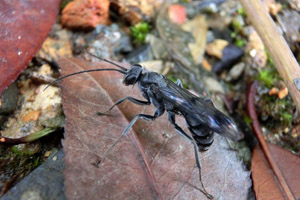The Great Chinese Wall of Ants

The “bone-house wasp” / Source: Michael Staab
A German-Chinese research team has discovered a wasp with a unique nest-building strategy in the forests of southeast China:
The “bone-house wasp” shuts off its nest with a chamber full of dead ants in order to protect its offspring from enemies, as shown by Michael Staab and Prof. Dr. Alexandra-Maria Klein from the Institute of Earth and Environmental Sciences of the University of Freiburg as well as scientists from the Museum für Naturkunde Berlin and the Chinese Academy of Sciences in Beijing.
No other such strategy has ever been discovered before in the entire animal kingdom. “When I first saw one of these ant-filled chambers, I thought immediately of the ancient Great Wall of China. Just like the Great Wall protected the Chinese Empire against attacks from raiding nomad tribes, the ant wall protects the offspring of this newly described wasp species from enemies,” recounts Staab. The scientists published their findings in the international journal PLOS ONE.
The new species with the scientific name Deuteragenia ossarium belongs to the family of spider wasps. In most species of this family, each of the females builds her own nest consisting of several cells. Each cell is filled with a single spider that has previously been paralyzed by a sting and on which the larva feeds.
The same is also true of the newly discovered “bone-house wasp,” which in contrast to all other known spider wasp species does not leave the last cell empty but fills it with dead ants.
The scientists conducted experiments demonstrating that the ant wall is a very effective means of protecting the nest. The offspring of the “bone-house wasp” are attacked far less frequently than those of other wasps from the same ecosystem. The researchers assume that the unique ant wall gives the nest a smell similar to the nest of a well-fortified ant species, thus scaring off potential enemies.
The precise defense mechanism is still unclear and is the subject of current research. “The discovery of a new species raises new questions. We want to understand why biodiversity is important for a functioning ecosystem,” says Klein. The research group “Biodiversity-Ecosystem Functioning (BEF) China,” which conducted the research, is funded by the German Research Foundation.
More information on the DFG research group “BEF China”:
http://www.bef-china.de/index.php/en/
Original publication:
Staab, M., Ohl, M., Zhu, C.D., Klein, A.M. 2014. A unique nest-protection strategy in a new species of spider wasp. PLOS ONE. doi: 10.1371/journal.pone.0101592.
Contact:
Prof. Dr. Alexandra-Maria Klein
Chair of Nature Conservation and Landscape Ecology
University of Freiburg
Phone: +49 (0)761/203-67770 or (0)176/84321671 (mobile)
E-Mail: alexandra.klein@nature.uni-freiburg.de
Media Contact
All latest news from the category: Life Sciences and Chemistry
Articles and reports from the Life Sciences and chemistry area deal with applied and basic research into modern biology, chemistry and human medicine.
Valuable information can be found on a range of life sciences fields including bacteriology, biochemistry, bionics, bioinformatics, biophysics, biotechnology, genetics, geobotany, human biology, marine biology, microbiology, molecular biology, cellular biology, zoology, bioinorganic chemistry, microchemistry and environmental chemistry.
Newest articles

Properties of new materials for microchips
… can now be measured well. Reseachers of Delft University of Technology demonstrated measuring performance properties of ultrathin silicon membranes. Making ever smaller and more powerful chips requires new ultrathin…

Floating solar’s potential
… to support sustainable development by addressing climate, water, and energy goals holistically. A new study published this week in Nature Energy raises the potential for floating solar photovoltaics (FPV)…

Skyrmions move at record speeds
… a step towards the computing of the future. An international research team led by scientists from the CNRS1 has discovered that the magnetic nanobubbles2 known as skyrmions can be…





















